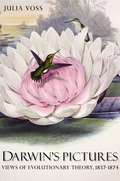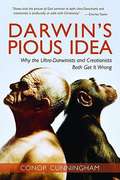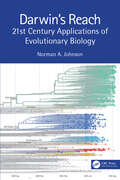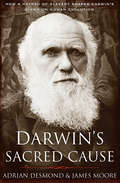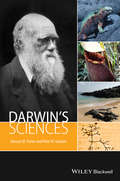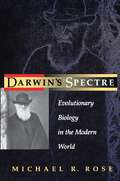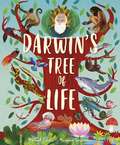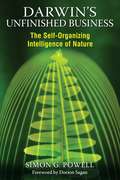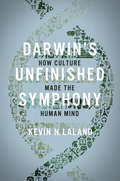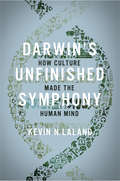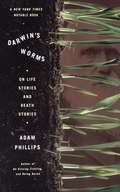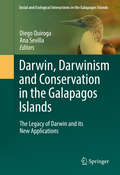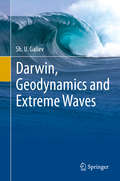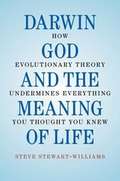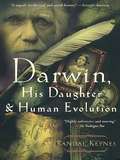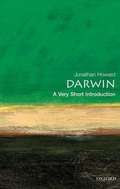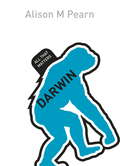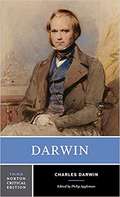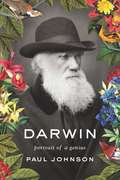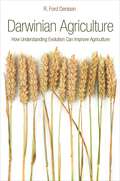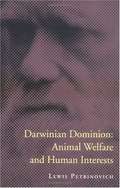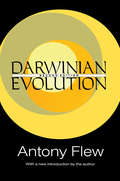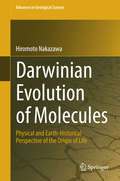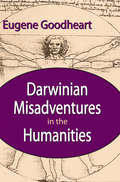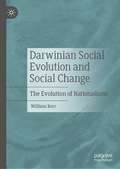- Table View
- List View
Darwin's Pictures: Views of Evolutionary Theory, 1837-1874
by Julia VossIn this first-ever examination of Charles Darwin's sketches, drawings, and illustrations, Julia Voss presents the history of evolutionary theory told in pictures. Darwin had a life-long interest in pictorial representations of nature, sketching out his evolutionary theory and related ideas for over forty years. Voss details the pictorial history of Darwin's theory of evolution, starting with his notebook sketches of 1837 and ending with the illustrations inThe Expression of Emotions in Man and Animals(1872). These images were profoundly significant for Darwin's long-term argument for evolutionary theory; each characterizes a different aspect of his relationship with the visual information and constitutes what can be called an "icon" of evolution. Voss shows how Darwin "thought with his eyes" and how his pictorial representations and the development and popularization of the theory of evolution were vitally interconnected. Voss explores four of Darwin's images in depth, and weaves about them a story on the development and presentation of Darwin's theory, in which she also addresses the history of Victorian illustration, the role of images in science, the technologies of production, and the relationship between specimen, words, and images.
Darwin's Pious Idea: Why the Ultra-Darwinists and Creationists Both Get It Wrong
by Conor CunninghamIn "Darwin's Pious Idea," Cunningham puts forth a compelling, cutting-edge case for both creation and evolution, drawing skillfully on an array of philosophical, theological, historical, and scientific sources to buttress his arguments.
Darwin's Reach: 21st Century Applications of Evolutionary Biology
by Norman A. JohnsonThe application of evolutionary biology addresses a wide range of practical problems in medicine, agriculture, the environment, and society. Such cutting-edge applications are emerging due to recent advances in DNA sequencing, new gene editing tools, and computational methods. This book is about applied evolution – the application of the principles of and information about evolutionary biology to diverse practical matters. Although applied evolution has existed, unrecognized, for a very long time, today’s version has a much wider scope. Evolutionary medicine has formed into its own discipline. Evolutionary approaches have long been employed in agriculture and in conservation biology. But Darwin’s reach now extends beyond just these three fields. It now also includes forensic biology and the law. Ideas from evolutionary biology can be used to inform policy regarding foreign affairs and national security. Applied evolution is not only interdisciplinary, but also multidisciplinary. Consequently, this book is for experts in one field who are interested in expanding their evolutionary horizons. It is also for students, at the undergraduate and graduate levels. One of the public relations challenges faced by evolutionary biology is that most people do not see it being all that relevant to their daily lives. Even many who accept evolution do not grasp how far Darwin’s reach extends. This book will change that perception. Key Features Emphasizes the expanding role evolutionary biology has in today’s world. Includes examples from medicine, law, agriculture, conservation, and even national security Summarizes new technologies and computational methods that originated as innovations based in part or whole on evolutionary theory. Current. Has extensive coverage of the COVID-19 pandemic and other recent topics. Documents the important role evolution plays in everyday life. Illustrates the broadly interdisciplinary nature of evolutionary theory. Resources The applications of evolutionary biology are far too numerous to include in just one book. Plus, new scientific findings emerge almost every day underscoring the central role evolution plays in our lives. The author has established a blog site to highlight these fascinating discoveries. Please visit https://darwinsreach.blog to be inspired by “… endless forms most beautiful and most wonderful [that] have been, and are being evolved.” (the last line of Charles Darwin’s The Origin of Species).
Darwin's Sacred Cause: How a Hatred of Slavery Shaped Darwin's Views on Human Evolution
by James Moore Adrian DesmondAn &“arresting&” and deeply personal portrait that &“confront[s] the touchy subject of Darwin and race head on&” (The New York Times Book Review). It&’s difficult to overstate the profound risk Charles Darwin took in publishing his theory of evolution. How and why would a quiet, respectable gentleman, a pillar of his parish, produce one of the most radical ideas in the history of human thought? Drawing on a wealth of manuscripts, family letters, diaries, and even ships&’ logs, Adrian Desmond and James Moore have restored the moral missing link to the story of Charles Darwin&’s historic achievement. Nineteenth-century apologists for slavery argued that blacks and whites had originated as separate species, with whites created superior. Darwin, however, believed that the races belonged to the same human family. Slavery was therefore a sin, and abolishing it became Darwin&’s sacred cause. His theory of evolution gave a common ancestor not only to all races, but to all biological life. This &“masterful&” book restores the missing moral core of Darwin&’s evolutionary universe, providing a completely new account of how he came to his shattering theories about human origins (Publishers Weekly, starred review). It will revolutionize your view of the great naturalist. &“An illuminating new book.&” —Smithsonian &“Compelling . . . Desmond and Moore aptly describe Darwin&’s interaction with some of the thorniest social and political issues of the day.&” —Wired &“This exciting book is sure to create a stir.&” —Janet Browne, Aramont Professor of the History of Science, Harvard University, and author of Charles Darwin: Voyaging
Darwin's Sciences
by Peter Graham Duncan PorterA complete scientific biography of Darwin that takes into account the latest research findings, both published and unpublished, on the life of this remarkable man. Considered the first book to thoroughly emphasize Darwin's research in various fields of endeavor, what he did, why he did it, and its implications for his time and ours. Rather than following a strictly chronological approach - a narrative choice that characteristically offers an ascent to On the Origin of Species (1859) with a rapid decline in interest following its publication and reception - this book stresses the diversity and full extent of Darwin's career by providing a series of chapters centering on various intellectual topics and scientific specializations that interested Darwin throughout his life. Authored by academics with years of teaching and discussing Darwin, Darwin's Sciences is suited to any biologist who is interested in the deeper inplications of Darwin's research.
Darwin's Spectre: Evolutionary Biology in the Modern World
by Michael R. RoseExtending the human life-span past 120 years. The "green" revolution. Evolution and human psychology. These subjects make today's newspaper headlines. Yet much of the science underlying these topics stems from a book published nearly 140 years ago--Charles Darwin's On the Origin of Species. Far from an antique idea restricted to the nineteenth century, the theory of evolution is one of the most potent concepts in all of modern science. In Darwin's Spectre, Michael Rose provides the general reader with an introduction to the theory of evolution: its beginning with Darwin, its key concepts, and how it may affect us in the future. First comes a brief biographical sketch of Darwin. Next, Rose gives a primer on the three most important concepts in evolutionary theory--variation, selection, and adaptation. With a firm grasp of these concepts, the reader is ready to look at modern applications of evolutionary theory. Discussing agriculture, Rose shows how even before Darwin farmers and ranchers unknowingly experimented with evolution. Medical research, however, has ignored Darwin's lessons until recently, with potentially grave consequences. Finally, evolution supplies important new vantage points on human nature. If humans weren't created by deities, then our nature may be determined more by evolution than we have understood. Or it may not be. In this question, as in many others, the Darwinian perspective is one of the most important for understanding human affairs in the modern world. Darwin's Spectre explains how evolutionary biology has been used to support both valuable applied research, particularly in agriculture, and truly frightening objectives, such as Nazi eugenics. Darwin's legacy has been a comfort and a scourge. But it has never been irrelevant.
Darwin's Tree of Life
by Michael BrightFollow the evolution of plants and animals, from the first living things 6 billion years ago to the animals living in the world today. Darwin's Tree of Life shows how the incredible diversity of life on earth came to be. This beautifully illustrated book starts from the dawn of life and shows the order in which plants and animals evolved, the different branches of 'The Tree of Life', and how plants and animals have changed over time in many amazingly different ways. Find out:· why crabs run sideway· which fish was the first to walk on land· why birds are similar to dinosaurs · why human brains are located in the head and not in our feet. which creatures can survive 30 years without eating· which mammal has the strongest bite of any predator· why hedgehogs have spinesStunningly illustrated by illustrator and print maker, Margaux Carpentier, children will enjoy finding out about a whole world of wonderful animals on our amazing planet Earth.The author, Michael Bright, has worked as an executive producer with the BBC's world-renowned Natural History Unit, based in Bristol, and with its Science Unit in London. He is author of over a hundred books on wildlife, science, travel, and conservation, including many for children. His bestseller Africa: Eye to Eye with the Unknown accompanied the popular television series presented by Sir David Attenborough. He is the recipient of many international radio and television awards, including the prestigious Prix Italia. He is a graduate of the University of London and a corporate biologist and member of the Royal Society of Biology.This book is perfect for the study of evolution, adaptation and inheritance in KS2 and KS2 science and covers topics such as classification, habitats and conservation.
Darwin's Unfinished Business: The Self-Organizing Intelligence of Nature
by Dorion Sagan Simon G. PowellA groundbreaking interpretation of evolution as the work of Nature’s intelligence • Refutes the orthodox view of evolution as a mindless process driven by chance • Explains why context is more important than mutation in evolutionary innovation • Shows how, by recognizing Nature’s innovative and creative powers, we can overcome our social and environmental challenges with a new green science of evolution Darwin’s theory of evolution is undoubtedly one of the most important scientific ideas of the modern age, explaining the existence of both life and consciousness without recourse to divine intervention. Yet how do we interpret evolution? How do we evaluate the ability of Nature to engineer something as exquisite as the genetic code or the human brain? Could it be that evolution is an intelligent process? Is Nature smart? According to most scientists, the answer is no. While humanity may be intelligent and purposeful, the natural processes that crafted us are deemed to be devoid of such attributes. In a radical move away from orthodoxy, Simon G. Powell extends Darwin’s vision by showing that evolution is not just about the survival of the fittest but rather the survival of clever and sensible behavior. Revealing the importance of the context in which things evolve, he explores the intelligent learning process behind natural selection. Rich with examples of the incredibly complex plants, animals, insects, and marine life designed by Nature--from the carnivorous Venus flytrap and the fungus-farming leafcutter ant to the symbiotic microbes found inside the common cow--he shows Nature as a whole to be a system of self-organizing intelligence in which life and consciousness were always destined to emerge. Examining the origins of life and the failure of artificial intelligence to compete with natural intelligence, he explains how our scientifically narrow-minded views on intelligence are now acting as a barrier to our own evolution. As Darwin’s unfinished business comes to light and Nature’s intelligence is embraced, we learn that Nature’s agenda is not simply the replication of genetic matter but of expanding consciousness. By working with Nature’s creative and innovative powers instead of against them, we can address today’s social and environmental challenges with a new green science of evolution.
Darwin's Unfinished Symphony: How Culture Made the Human Mind
by Kevin N. LalandHumans possess an extraordinary capacity for cultural production, from the arts and language to science and technology. How did the human mind—and the uniquely human ability to devise and transmit culture—evolve from its roots in animal behavior? Darwin's Unfinished Symphony presents a captivating new theory of human cognitive evolution. This compelling and accessible book reveals how culture is not just the magnificent end product of an evolutionary process that produced a species unlike all others—it is also the key driving force behind that process.Kevin Laland shows how the learned and socially transmitted activities of our ancestors shaped our intellects through accelerating cycles of evolutionary feedback. The truly unique characteristics of our species—such as our intelligence, language, teaching, and cooperation—are not adaptive responses to predators, disease, or other external conditions. Rather, humans are creatures of their own making. Drawing on his own groundbreaking research, and bringing it to life with vivid natural history, Laland explains how animals imitate, innovate, and have remarkable traditions of their own. He traces our rise from scavenger apes in prehistory to modern humans able to design iPhones, dance the tango, and send astronauts into space.This book tells the story of the painstaking fieldwork, the key experiments, the false leads, and the stunning scientific breakthroughs that led to this new understanding of how culture transformed human evolution. It is the story of how Darwin's intellectual descendants picked up where he left off and took up the challenge of providing a scientific account of the evolution of the human mind.
Darwin's Unfinished Symphony: How Culture Made the Human Mind
by Kevin N. LalandHumans possess an extraordinary capacity for culture, from the arts and language to science and technology. But how did the human mind—and the uniquely human ability to devise and transmit culture—evolve from its roots in animal behavior? Darwin’s Unfinished Symphony presents a captivating new theory of human cognitive evolution. This compelling and accessible book reveals how culture is not just the magnificent end product of an evolutionary process that produced a species unlike all others—it is also the key driving force behind that process. Kevin Laland tells the story of the painstaking fieldwork, the key experiments, the false leads, and the stunning scientific breakthroughs that led to this new understanding of how culture transformed human evolution. It is the story of how Darwin’s intellectual descendants picked up where he left off and took up the challenge of providing a scientific account of the evolution of the human mind.
Darwin's Worms: On Life Stories and Death Stories
by Adam PhillipsAdam Phillips has been called "the psychotherapist of the floating world" and "the closest thing we have to a philosopher of happiness. " His style is epigrammatic; his intelligence, electric. His new book, Darwin's Worms, uses the biographical details of Darwin's and Freud's lives to examine endings-suffering, mortality, extinction, and death. Both Freud and Darwin were interested in how destruction conserves life. They took their inspiration from fossils or from half-remembered dreams. Each told a story that has altered our perception of our lives. For Darwin, Phillips explains, "the story to tell was how species can drift towards extinction; for Freud, the story was how the individual tended to, and tended towards his own death. " In each case, it is a death story that uniquely illuminates the life story.
Darwin, Darwinism and Conservation in the Galapagos Islands: The Legacy of Darwin and its New Applications (Social and Ecological Interactions in the Galapagos Islands)
by Diego Quiroga Ana SevillaThe book explores how Darwin#65533;s legendary and mythologized visit to the Galapagos affected the socioecosystems of the Islands, as well as the cultural and intellectual traditions of Ecuador and Latin America. It highlights in what way the connection between Darwin and the Galapagos has had real, enduring and paradoxical effects in the Archipelago. This Twenty Century construct of the Galapagos as the cradle of Darwin's theory and insights triggered not only the definition of the Galapagos as a living natural laboratory but also the production of a series of conservation practices and the reshaping of the Galapagos as a tourism destination with an increasingly important flow of tourists that potentially threaten its fragile ecosystems. The book argues that the idea of a Darwinian living laboratory has been limited by the success of the very same constructs that promote its conservation. It suggests critical interpretations of this paradox by questioning many of the dichotomies that have been created to understand nature and its conservation. We also explore some possible ways in which Darwin's ideas can be used to better understand the social and natural threats facing the Islands and to develop sustainable and successful management practices.
Darwin, Geodynamics and Extreme Waves
by Sh. U. GalievThis book examines the reasons behind the resonant amplification of seismic and ocean waves that have the capacity to destroy cities and ocean-going vessels. Using Charles Darwin's important geophysical research as a starting point, it provides insights into the interaction between earthquakes with volcanoes, seaquake, and tsunami formation. In particular, the author details the observations that Darwin made on a powerful earthquake that occurred in Chile in 1835, noting how the famous naturalist and geologist used the concept of earthquake-induced vertical shock to explain the event's devastating impact. The book then goes on to show how Darwin's concept relates to the catastrophic results of the shallow quakes that recently destroyed Port-au-Prince (Haiti, 2010) and severely damaged Christchurch (New Zealand, 2011). In addition, the author asks whether Darwin's ideas are endorsed by the discoveries of modern science and whether the results of destructive earthquakes can be modeled using strongly nonlinear wave equations. Coverage also proposes that similar equations can be used to simulate the dynamics of many objects on the surface of the Earth, and to model the origin of the Universe, dark matter, and dark energy as strongly nonlinear wave phenomena. The book will appeal to students as well as researchers and engineers in geophysics, seismology, nonlinear wave studies, cosmology, physical oceanography, and ocean and coastal engineering. It will also be of use to those who are interested in the phenomena of natural catastrophes as well as those who want to learn more about the life and work of Charles Darwin.
Darwin, God and the Meaning of Life
by Steve Stewart-Williams"If you accept evolutionary theory, can you also believe in God? Are human beings superior to other animals, or is this just a human prejudice? Does Darwin have implications for heated issues like euthanasia and animal rights? Does evolution tell us the purpose of life or does it imply that life has no ultimate purpose? Does evolution tell us what is morally right and wrong or does it imply that ultimately nothing is right or wrong? In this fascinating and intriguing book, Steve Stewart-Williams addresses these and other fundamental philosophical questions raised by evolutionary theory and the exciting new field of evolutionary psychology. Drawing on biology, psychology and philosophy, he argues that Darwinian science supports a view of a godless universe devoid of ultimate purpose or moral structure, but that we can still live a good life and a happy life within the confines of this view"--"Evolutionary theory answers one of the most profound and fundamental questions human beings have ever asked themselves, a question that has plagued reflective minds for as long as reflective minds have existed in the universe: Why are we here? How did we come to exist on this planet? In a lot of ways, this is a very ordinary planet"--
Darwin, His Daughter, and Human Evolution
by Randal KeynesIn a chest of drawers bequeathed by his grandmother, author Randal Keynes discovered the writing case of Charles and Emma Darwin’s beloved daughter Annie Darwin, who died at the age of ten. He also found the notes Darwin kept throughout Annie's illness, the eulogy he delivered at her funeral-and provocative new insights into Darwin’s views on nature, evolution, and the human condition. In Darwin, His Daughter & Human Evolution, Keynes shows that Darwin was not "a cold intellect with no place for love in his famous 'struggle for existence,' [but]. . . a man of uncommon warmth" (Scientific American). Creation: The True Story of Charles Darwin is now a major motion picture and the movie tie-in paperback is also available from Riverhead Books. .
Darwin: A Very Short Introduction
by Jonathan HowardDarwin's theory that man's ancestors were apes caused an uproar within the scientific world, as well as public frenzy when The Origin of Species was published in 1859. Arguments still rage about the implications of his evolutionary theory, and skepticism about the value of Darwin's contribution to knowledge is widespread. In this analysis of Darwin's major insights and arguments, Jonathan Howard reasserts the importance of Darwin's work for the development of modern biology. He offers a stimulating view of the famous scientist in a concise, handy format, making it a masterpiece for all Darwinians as well as for all general readers of popular science.
Darwin: All That Matters (All That Matters)
by Alison PearnCharles Darwin's name is among the most recognised in the world, and more than 100 years after his death his books are still best-sellers; there are more than ten modern editions of the most famous, On the Origin of Species, currently available. His theories of descent with modification and of sexual selection are among the most influential ever formulated, but those theories, which imply the interconnectedness not just of humans and animals but of every living thing, are often imperfectly understood, or even willfully misrepresented, and Darwin himself is reduced to a two-dimensional character, a cipher deployed in the guerilla warfare between fundamentalist religion and hard line atheism. How many people know that Darwin was famous among his family and friends for his sense of fun? Darwin: All That Matters puts his life, personality, and the full breadth and significance of his work in context, with greater emphasis on his post-Origin work. It is perfect for those who want to gain a sound grasp of the subject quickly, and those looking for a good entry-level book as a starting point for further study.
Darwin: Norton Critical Editions
by Philip Appleman<p>The impact of Charles Darwin’s work on Western civilization has been broad and deep. As much as anyone in the modern era, he changed human thought, and his influence is still felt in virtually all aspects of our lives. This new edition, larger and more varied than the previous ones, includes more of Darwin's own work and also presents the most recent research and scholarship on all aspects of Darwin’s legacy. The biological sciences, as well as social thought, philosophy, ethics, religion, and literature, have all been shaped and reshaped by evolutionary concepts. <p>Excerpts from the most important books and articles of recent years confirm this Darwinian heritage. New work by Richard Dawkins, Edward O. Wilson, Kevin Padian, Eugene C. Scott, Steven Pinker, Daniel Dennett, Michael Ruse, Frans de Waal, Noretta Koertge, George C. Williams, George Levine, Stephen Jay Gould, Gillian Beer, Ernst Mayr, and many others illuminates this exciting intellectual history. A wide-ranging new introduction by the editor provides context and coherence to this rich body of engaging material, much of which will be shaping human thought well into the new century.</p>
Darwin: portrait of a genius
by Paul JohnsonEminent historian Paul Johnson provides a rich, succinct portrait of Charles Darwin Charles Darwin is arguably the most influential scientist of all time. His Origin of Species forever changed our concept of the world’s creation. Darwin’s revolutionary career is the perfect vehicle for historian Paul Johnson. Marked by the insightful observation, spectacular wit, and highly readable prose for which Johnson is so well regarded, Darwin brings the gentleman-scientist and his times brilliantly into focus. From Darwin’s birth into great fortune to his voyage aboard the Beagle, to the long-delayed publication of his masterpiece, Johnson delves into what made this Victorian gentleman into a visionary scientist—and into the tragic flaws that later led Darwin to support the burgeoning eugenics movement. Johnson’s many admirers as well as history and science buffs will be grateful for this superb account of Darwin and the everlasting impact of his discoveries. .
Darwinian Agriculture: How Understanding Evolution Can Improve Agriculture
by R. Ford DenisonHarnessing evolution for more sustainable agricultureAs human populations grow and resources are depleted, agriculture will need to use land, water, and other resources more efficiently and without sacrificing long-term sustainability. Darwinian Agriculture presents an entirely new approach to these challenges, one that draws on the principles of evolution and natural selection.R. Ford Denison shows how both biotechnology and traditional plant breeding can use Darwinian insights to identify promising routes for crop genetic improvement and avoid costly dead ends. Denison explains why plant traits that have been genetically optimized by individual selection—such as photosynthesis and drought tolerance—are bad candidates for genetic improvement. Traits like plant height and leaf angle, which determine the collective performance of plant communities, offer more room for improvement. Agriculturalists can also benefit from more sophisticated comparisons among natural communities and from the study of wild species in the landscapes where they evolved.Darwinian Agriculture reveals why it is sometimes better to slow or even reverse evolutionary trends when they are inconsistent with our present goals, and how we can glean new ideas from natural selection's marvelous innovations in wild species.
Darwinian Dominion: Animal Welfare and Human Interests
by Lewis PetrinovichThe controversial subject of this book is the permissible use of animals by humans. Lewis Petrinovich argues that humans have a set of cognitive abilities, developing from a suite of emotional attachments, that make them unique among species.
Darwinian Evolution
by Antony FlewIn little more than a hundred years the evolutionary theory of Charles Darwin has conquered the thinking world. No other body of ideas has enjoyed such unrivaled success. But precisely because of its scientific status, Darwinism has sometimes been invoked to sustain other ideas and beliefs with a much less solid foundation. Darwinian Evolution is a study of the historical background of Darwin's ideas, of their logical structure, and of their alleged and actual implications.Flew explores the Scottish Enlightenment, an important and often neglected aspect of Darwin's intellectual background. He compares Darwin with such figures as Adam Smith, Thomas Malthus, and Karl Marx, emphasizing not the similarities, but the differences between the natural and social sciences. Flew argues that social science must do what natural science does not: take account of individual choice. He examines the creationist controversy in Britain and the United States and discusses the possibility of a human sociobiology.In his new introduction, Flew updates his book by discussing relevant works that have appeared since it was published thirteen years ago. He discusses two different tendencies among both social scientists and those who develop or promote social policies according to various findings in the social sciences: (1) to assume there is no such thing as human nature; and (2) to take no account of the possibility that differences between sets of individuals may be genetically determined. Flew maintains that both these tendencies violate Darwin's theory. Darwinian Evolution is an intriguing study that should be read by sociologists, biologists, philosophers, and all those interested in the impact of Darwin and his work.
Darwinian Evolution of Molecules: Physical and Earth-Historical Perspective of the Origin of Life (Advances in Geological Science)
by Hiromoto NakazawaOn the basis of thermodynamic considerations and the Earth’s historical processes, this book argues the physical inevitability of life’s generation and evolution, i.e., Why did life generate? Why does life evolve? Following an introduction to the problem, the hypothesis “Darwinian Evolution of Molecules” is proposed, which explains how, when, and where life was instigated through successive chemical reactions and the survival of selected molecules. The individual processes described are all scientifically reasonable, being verifiable by experiment. The hypothesis is supported by extensive reference to the scientific literature published in academic journals, including some experimental reports from the author’s own research group. The readers of this book will learn that the decreasing temperature of the early Earth led to a reduction in its entropy, inducing the Earth’s materials to order, which entailed ordering of the light elements as organic molecules with subsequent further ordering (i.e., evolution) to systems that can be considered alive (i.e., life). Researchers and students, as well as the non-academic audience, interested in the interdisciplinary problem of the origin of life will find suggestions and possible approaches to the scientific and conceptual problems they may be facing.
Darwinian Misadventures in the Humanities
by Eugene GoodheartIn recent decades the humanities have been in thrall to postmodern skepticism, while Darwinists, brimming with confidence in the genuine progress they have made in the sciences of biology and psychology, have set their sights on rescuing the humanities from the ravages of postmodernism. In this volume, Eugene Goodheart attacks the neo-Darwinist approach to the arts and articulates a powerful defense of humanist criticism. E. O. Wilson, the distinguished Harvard biologist, has spoken of converting philosophy into science, substituting science for religion, and formulating a biological theory of literature and the arts in Consilence: The Unity of Knowledge. Goodheart demonstrates that Wilson's efforts, and those of his colleagues Richard Dawkins, Steven Pinker, and Daniel Dennett among others, have resulted in scientism rather than science. If, for example, Dawkins had contented himself in The Selfish Gene with the claim that Darwinism had made worthless other answers to the question of how we have evolved, he would have given offense only to creationists, but questions of meaning and purpose are of another order. Contemporary Darwinist critiques err in assuming that art and traditional criticism aspire to truths that can be codified in terms of scientific laws. If this were so, we would have to regard the speculations of Plato, Aristotle, Augustine, Montaigne, Shakespeare, and Rousseau as worthless. Goodheart exposes the philistinism of literary Darwinism, the bad faith and inverted fundamentalism of the Darwinian approach to religion, and the dangers of the eff ort to create a Darwinian ethical system. Taken together, Goodheart's arguments show that in moving beyond their area of competence, the neo -Darwinists commit an ideology, not a science.
Darwinian Social Evolution and Social Change: The Evolution of Nationalisms
by William KerrThis book introduces the value of a Darwinian social evolutionary approach to understanding social change. The chapters discuss several different perspectives on social evolutionary theory, and go on to link these with comparative and historical sociological theory, and two case-studies. Kerr brings together social change theory and theories on nationalism, whilst also providing concrete examples of the theories at work. The book offers a vision of rapprochement between these different areas of theory and study, and to where this could lead future studies of comparative history and sociology. As such, it should be useful to scholars and students of nationalism and social change, sociologists, political scientist and historians.
